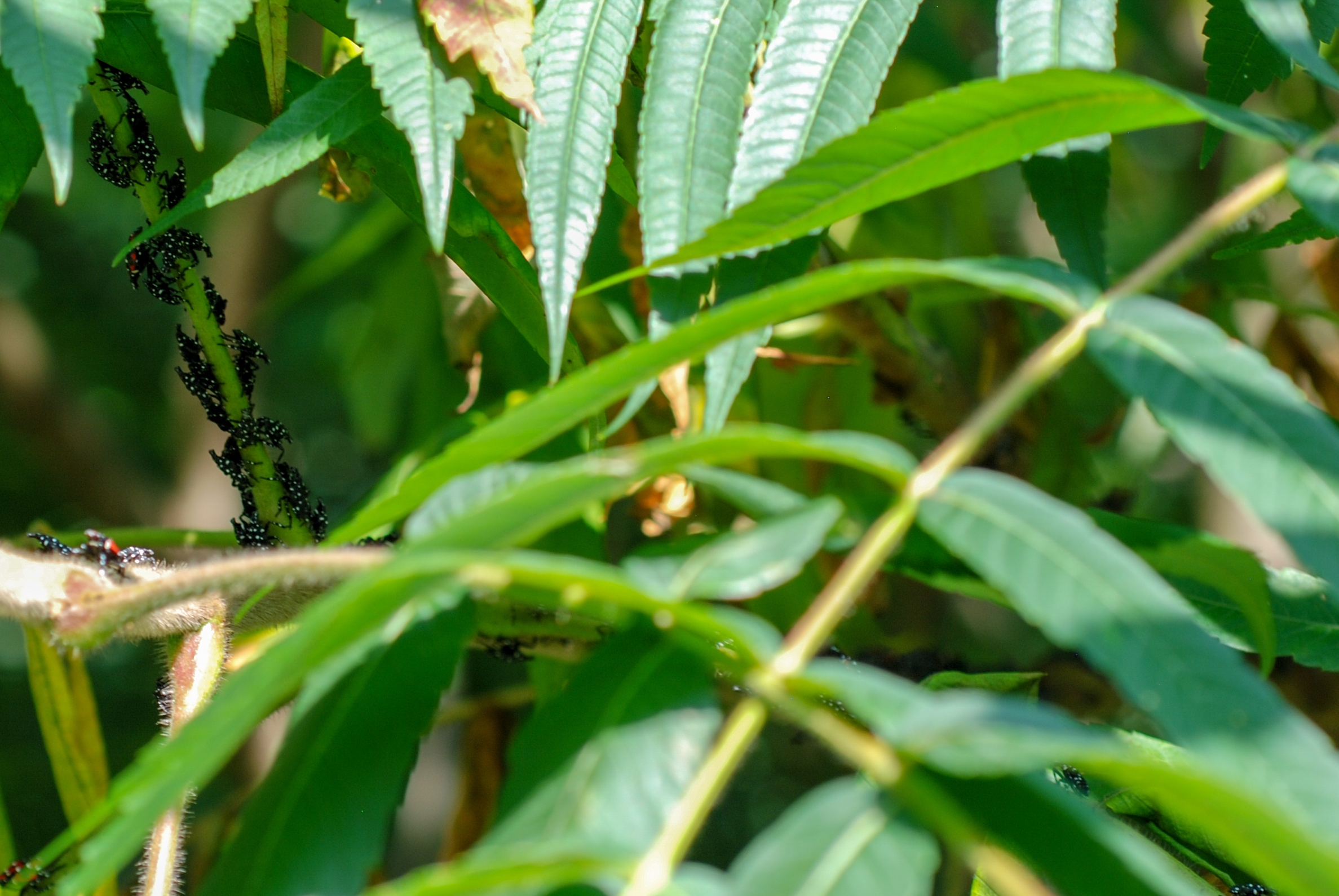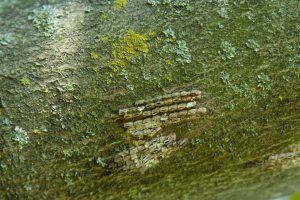Spotted lanternfly hatch out as temperatures rise
Department of Agriculture | Date Posted: Thursday, May 9, 2019
Department of Agriculture | Date Posted: Thursday, May 9, 2019

DOVER, Del. – The steady increase in daily temperatures has spurred spotted lanternfly nymphs to hatch out of their egg masses. While the hatching will continue for the next few weeks, this causes concern for businesses, residents, and the agriculture industry because this notorious hitchhiker will be on the move.
“From the time we enacted the emergency quarantine in March, New Castle County residents and businesses had a window of time to look for and destroy spotted lanternfly egg masses,” said Jessica Inhof, Delaware Department of Agriculture Plant Industries Administrator. “We had a good response from the public on taking action against this invasive pest, learning what the quarantine means, and from businesses engaging in the permitting process. Now that the insect will be mobile, regulated articles moving within and out of the quarantine zone need to be inspected.”
The Delaware Department of Agriculture (DDA) quarantined eleven zip codes in New Castle County to eradicate, control, and prevent the spread of spotted lanternfly in Delaware and to surrounding states. The following zip codes in New Castle County are quarantined in their entirety: 19702, 19703, 19707, 19711, 19801, 19802, 19803, 19805, 19807, 19809, and 19810. The quarantine can expand if there is reason to believe that the pest has moved to a non-quarantined area. Spotted lanternfly nymphs and adults can fly, hop, or drop onto a vehicle – meaning this pest can easily be transported to new areas where it can create another infestation.
 “We know from working with this pest that as many egg masses destroyed from the ground, there are that many, if not more, up in the tree canopy, that people cannot access,” said Stephen Hauss, DDA Environmental Scientist. “As the nymphs move down to find nutrition, these are the ones we need to work to eradicate this year.”
“We know from working with this pest that as many egg masses destroyed from the ground, there are that many, if not more, up in the tree canopy, that people cannot access,” said Stephen Hauss, DDA Environmental Scientist. “As the nymphs move down to find nutrition, these are the ones we need to work to eradicate this year.”
The spotted lanternfly is a destructive invasive plant hopper that attacks many hosts including trees, shrubs, orchards, grapes, and hops. The insect is detrimental to Delaware’s agricultural industry, forests, and residential areas. Due to quarantines in other states, interstate commerce will be impacted if the pest is transported out of the Delaware quarantine area.
Examples of regulated articles include:
In order to move regulated items, the general public will need to complete a residential compliance checklist indicating they inspected and know that no living life stage of the spotted lanternfly is present on the articles. The checklist is available online at https://de.gov/hitchhikerbug.
Any person conducting business for a commercial business, municipalities, or a government agency that requires movement of any regulated item within or from the quarantine area must have a permit, available through the DDA spotted lanternfly website. To obtain a permit, a designated individual from an organization must receive training and pass an online test to demonstrate a working knowledge and understanding of the pest and quarantine requirements. Training of other employees, inspection of vehicle and products, and removal of living stages of spotted lanternfly must be completed. The permit demonstrates the individual understands how to identify the pest and can ensure the items transported are not carrying the insect.
For more detailed information regarding the emergency quarantine, permitting, treatment, or to report a sighting of spotted lanternfly, visit the Delaware Department of Agriculture’s dedicated spotted lanternfly webpage at https://de.gov/hitchhikerbug or call the dedicated spotted lanternfly hotline at (302) 698-4632. When leaving a message, leave your contact information and, if reporting a sighting, please provide the location of the sighting.
###
Media Contact: Stacey Hofmann, (302) 698-4542, Stacey.Hofmann@delaware.gov
Keep up to date by receiving a daily digest email, around noon, of current news release posts from state agencies on news.delaware.gov.
Here you can subscribe to future news updates.
Department of Agriculture | Date Posted: Thursday, May 9, 2019

DOVER, Del. – The steady increase in daily temperatures has spurred spotted lanternfly nymphs to hatch out of their egg masses. While the hatching will continue for the next few weeks, this causes concern for businesses, residents, and the agriculture industry because this notorious hitchhiker will be on the move.
“From the time we enacted the emergency quarantine in March, New Castle County residents and businesses had a window of time to look for and destroy spotted lanternfly egg masses,” said Jessica Inhof, Delaware Department of Agriculture Plant Industries Administrator. “We had a good response from the public on taking action against this invasive pest, learning what the quarantine means, and from businesses engaging in the permitting process. Now that the insect will be mobile, regulated articles moving within and out of the quarantine zone need to be inspected.”
The Delaware Department of Agriculture (DDA) quarantined eleven zip codes in New Castle County to eradicate, control, and prevent the spread of spotted lanternfly in Delaware and to surrounding states. The following zip codes in New Castle County are quarantined in their entirety: 19702, 19703, 19707, 19711, 19801, 19802, 19803, 19805, 19807, 19809, and 19810. The quarantine can expand if there is reason to believe that the pest has moved to a non-quarantined area. Spotted lanternfly nymphs and adults can fly, hop, or drop onto a vehicle – meaning this pest can easily be transported to new areas where it can create another infestation.
 “We know from working with this pest that as many egg masses destroyed from the ground, there are that many, if not more, up in the tree canopy, that people cannot access,” said Stephen Hauss, DDA Environmental Scientist. “As the nymphs move down to find nutrition, these are the ones we need to work to eradicate this year.”
“We know from working with this pest that as many egg masses destroyed from the ground, there are that many, if not more, up in the tree canopy, that people cannot access,” said Stephen Hauss, DDA Environmental Scientist. “As the nymphs move down to find nutrition, these are the ones we need to work to eradicate this year.”
The spotted lanternfly is a destructive invasive plant hopper that attacks many hosts including trees, shrubs, orchards, grapes, and hops. The insect is detrimental to Delaware’s agricultural industry, forests, and residential areas. Due to quarantines in other states, interstate commerce will be impacted if the pest is transported out of the Delaware quarantine area.
Examples of regulated articles include:
In order to move regulated items, the general public will need to complete a residential compliance checklist indicating they inspected and know that no living life stage of the spotted lanternfly is present on the articles. The checklist is available online at https://de.gov/hitchhikerbug.
Any person conducting business for a commercial business, municipalities, or a government agency that requires movement of any regulated item within or from the quarantine area must have a permit, available through the DDA spotted lanternfly website. To obtain a permit, a designated individual from an organization must receive training and pass an online test to demonstrate a working knowledge and understanding of the pest and quarantine requirements. Training of other employees, inspection of vehicle and products, and removal of living stages of spotted lanternfly must be completed. The permit demonstrates the individual understands how to identify the pest and can ensure the items transported are not carrying the insect.
For more detailed information regarding the emergency quarantine, permitting, treatment, or to report a sighting of spotted lanternfly, visit the Delaware Department of Agriculture’s dedicated spotted lanternfly webpage at https://de.gov/hitchhikerbug or call the dedicated spotted lanternfly hotline at (302) 698-4632. When leaving a message, leave your contact information and, if reporting a sighting, please provide the location of the sighting.
###
Media Contact: Stacey Hofmann, (302) 698-4542, Stacey.Hofmann@delaware.gov
Keep up to date by receiving a daily digest email, around noon, of current news release posts from state agencies on news.delaware.gov.
Here you can subscribe to future news updates.